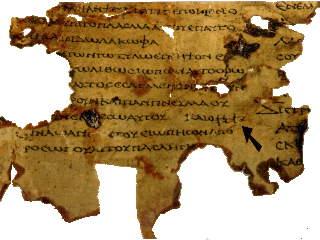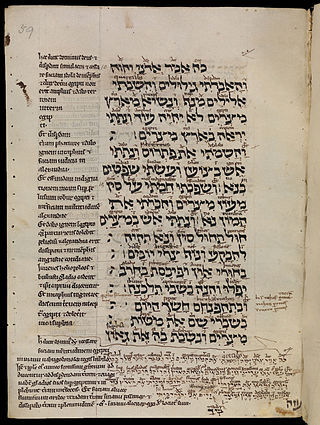
The Book of Ezekiel is the third of the Latter Prophets in the Tanakh and one of the major prophetic books, following Isaiah and Jeremiah. According to the book itself, it records six visions of the prophet Ezekiel, exiled in Babylon, during the 22 years from 593 to 571 BCE, although it is the product of a long and complex history and does not necessarily preserve the very words of the prophet.

The Dead Sea Scrolls are ancient Jewish and Hebrew religious manuscripts discovered between 1946 and 1956 at the Qumran Caves in what was then Mandatory Palestine, near Ein Feshkha in the West Bank, on the northern shore of the Dead Sea. Dating from the 3rd century BCE to the 1st century CE, the Dead Sea Scrolls are considered to be a keystone in the history of archaeology with great historical, religious, and linguistic significance because they include the oldest surviving manuscripts of entire books later included in the biblical canons, along with deuterocanonical and extra-biblical manuscripts which preserve evidence of the diversity of religious thought in late Second Temple Judaism. At the same time they cast new light on the emergence of Christianity and of Rabbinic Judaism. Most of the scrolls are held by Israel in the Shrine of the Book at the Israel Museum, but their ownership is disputed by Jordan due to the Qumran Caves' history: following the End of the British Mandate for Palestine in 1947, Jordan occupied the area in the 1948 Arab–Israeli War, and Israel captured both the area and several Scrolls from Jordan in the 1967 Six Day War. However, some of the scrolls are still in Jordan and are now displayed at The Jordan Museum in Amman. Ownership of the scrolls is also contested by the State of Palestine.

In the Book of Ezekiel in the Hebrew Bible, New Jerusalem is Ezekiel's prophetic vision of a city centered on the rebuilt Holy Temple, the Third Temple, to be established in Jerusalem, which would be the capital of the Messianic Kingdom, the meeting place of the twelve tribes of Israel, during the Messianic era. The prophecy is recorded by Ezekiel as having been received on Yom Kippur of the year 3372 of the Hebrew calendar.
The Apocryphon of Ezekiel is an apocryphal book, written in the style of the Old Testament, as revelations of Ezekiel. It survives only in five fragments including quotations in writings by Epiphanius, Clement of Rome and Clement of Alexandria, and the Chester Beatty Papyri 185. It is likely to have been composed c. 50 BC – 50 AD, although some scholars suggest a date closer to 7 AD.
Apocryphon, plural apocrypha, was a Greek term for a genre of Jewish and Early Christian writings that were meant to impart "secret teachings" or gnosis (knowledge) that could not be publicly taught. Jesus briefly withheld his messianic identity from the public. Based on that fact, some hypothesize without support that he also gave private instruction to the apostles, figures in the canonical Gospels of the New Testament and furnishes the material of the "sayings" Gospel of Thomas and part of the material of the Gospel of Mary. It is purportedly a secret teaching supposedly committed to a trusted disciple by Christ after his resurrection. The secret teaching in Gnostic literature refers to several things.
Emanuel Tov, is a Dutch–Israeli biblical scholar and linguist, emeritus J. L. Magnes Professor of Bible Studies in the Department of Bible at the Hebrew University of Jerusalem. He has been intimately involved with the Dead Sea Scrolls for many decades, and from 1991, he was appointed Editor-in-Chief of the Dead Sea Scrolls Publication Project.
4Q108 is a fragment containing a portion of the Song of Songs (3:7–8) in Hebrew. Fragments from three such scrolls were found in Cave 4 at Qumran. These, and 6Q6 from Cave 6, estimated from 2nd century BCE, comprise the total witness to the Song from the Dead Sea Scrolls, known so far.
Discoveries in the Judaean Desert (DJD) is the official 40-volume publication that serves as the editio princeps for the Dead Sea Scrolls. It is published by Oxford University Press.

The Genesis Apocryphon (1Q20), also called the Tales of the Patriarchs or the Apocalypse of Lamech and labeled 1QapGen, is one of the original seven Dead Sea Scrolls discovered in 1946 by Bedouin shepherds in Cave 1 near Qumran, a small settlement in the northwest corner of the Dead Sea. Composed in Aramaic, it consists of four sheets of leather. Furthermore, it is the least well-preserved document of the original seven. The document records a pseudepigraphal conversation between the biblical figure Lamech, son of Methuselah, and his son, Noah, as well as first and third person narratives associated with Abraham. It is one of the nonbiblical texts found at Qumran. A range of compositional dates for the work have been suggested from the 3rd century BC to 1st century AD. Palaeography and Carbon-14 dating were used to identify the age of the documents. It is 13 inches in length and 2.75 inches in width at its widest point in the middle.
4Q521 or the 4QMessianic Apocalypse is one of the Dead Sea Scrolls found in the Cave 4 near Qumran.

The Greek Minor Prophets Scroll from Nahal Hever is a Greek manuscript of a revision of the Septuagint dated to the 1st century CE. The manuscript is kept in the Rockefeller Museum in Jerusalem. It was first published by Dominique Barthélemy in 1963. The Rahlfs-Siglum is 943.
Carol A. Newsom is an American biblical scholar, historian of ancient Judaism, and literary critic. She is the Charles Howard Candler Professor Emerita of Old Testament at the Candler School of Theology and a former senior fellow at the Center for the Study of Law and Religion at Emory University. She is a leading expert on the Dead Sea Scrolls, Wisdom literature, and the Book of Daniel.

Discovered among the Dead Sea Scrolls near Qumran, Israel, were fragments of a scroll which describes New Jerusalem in minute detail. The New Jerusalem Scroll appears to contain an apocalyptic vision, an eschatological vision of the city and the temple, although, being fragmented, it is hard to categorize. Written in Aramaic, the text describes a vast city, rectangular in shape, with twelve gates and encircled by a long wall. Similar descriptions appear in Revelation 21–22 and comparison to the Temple Scroll shows many similarities despite no direct literary links between the two.
The Pesher on Genesis, or Commentaries on Genesis, is part of the collection of the Dead Sea Scrolls found in caves near the archaeological site of Qumran about a mile off the Northwestern shore of the Dead Sea. There are four fragmentary manuscripts that have been grouped together from Cave 4: 4Q252, 4Q253, 4Q254, and 4Q254a which contain interpretations of the Book of Genesis. The most extensive of the manuscripts is 4Q252 which contains 6 fragments. They date from mid 1st century BCE to late 1st century CE. They are all written in Hebrew on parchment.

Ezekiel 37 is the thirty-seventh chapter of the Book of Ezekiel in the Hebrew Bible or the Old Testament of the Christian Bible. This book contains the prophecies attributed to the prophet/priest Ezekiel, and is one of the Nevi'im (Prophets). This chapter contains a vision of the resurrection of dry bones, widely known as the Vision of the Valley of Dry Bones, in which Ezekiel at last assures the captives in Babylon that they will return from exile.

Ezekiel 7 is the seventh chapter of the Book of Ezekiel in the Hebrew Bible or the Old Testament of the Christian Bible. This book contains the prophecies attributed to the prophet/priest Ezekiel, and is one of the Books of the Prophets. In this chapter, Ezekiel announces that "judgment on Israel is near".

Ezekiel 29 is the twenty-ninth chapter of the Book of Ezekiel in the Hebrew Bible or the Old Testament of the Christian Bible. This book contains the prophecies attributed to the prophet/priest Ezekiel, and is one of the Books of the Prophets. Chapters 29–32 contain seven oracles against Egypt, balancing the seven oracles against Israel's smaller neighbors in chapters 25–28.

The manuscript 4Q127 is one of the Dead Sea Scrolls. It is probably a paraphrase of Exodus according to the Septuagint (LXX) of the biblical Book of Leviticus, found at Qumran. The Rahlfs-No. is 802. Palaeographically it dates from the first century BC. Currently the manuscript is housed in the Rockefeller Museum in Jerusalem.
4Q369, also known as the Prayer of Enosh, is one of the Dead Sea Scrolls found at Qumran Cave 4. The text was published in 1994 by editors Harold Attridge and John Strugnell as part of the DJD-series.

The 4Q126 is an ancient Greek fragment and one of the Dead Sea Scrolls. The text of this manuscript is unknown and it has not been possible to identify it with any known LXX passage, a biblical verse or from some other literary work. Palaeographically it dates from the first century BCE or early first century CE.








